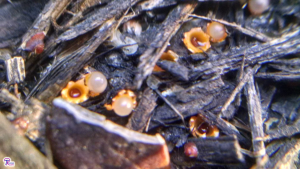#029: Mushroom Morphology: Chanterelles and Trumpets
This morphological group of mushrooms is defined by the presence of blunt ridges rather than true gills. These ridges can vary from well-developed, gill-like structures to small wrinkles on a nearly smooth hymenium (spore-bearing surface). Another defining feature of the chanterelles and trumpets is that the hymenium is always decurrent. This means that the ridges run down the stipe/stem, often going all the way to the ground. Chanterelles usually have a pileus (cap) that is flat to depressed in the center. The mushroom that defines this morphology is Cantharellus cibarius, commonly known as “The Golden Chanterelle,” or simply “The Chanterelle.” Trumpets, which are a subset of chanterelles, usually have a nearly smooth hymenium and are distinguished by an extremely depressed pileus, which results in the trumpet/vase/funnel shape of the fruiting bodies. This morphology is best illustrated by Craterellus cornucopioides and its almost indistinguishable American relative Craterellus fallax. Commonly known as...







![#011: Characteristics of Kingdom Fungi [Archived]](https://www.fungusfactfriday.com/wp-content/themes/hueman/assets/front/img/thumb-small-empty.png)

